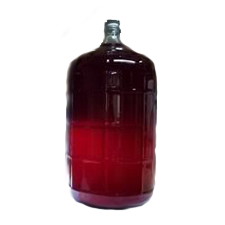The Gravity of Patience: A Winemaker's Guide to Outliving the Clearing Process
Posted by Matteo Lahm on 11th Mar 2024
If you are a winemaker who works from fresh fruit and you do not like using fining agents to clear your wine, you may have seen a carboy that looks like a lava lamp - darker and clear at the top, lighter and more opaque at the bottom. At first sight, it looks cool and if you are intent on allowing the natural process of gravity to clear your wine, you may become a zombie before that happens. That is if you are not prepared to act fast and do a little extra work.
Now, you could mistake stubbornness for patience insisting that it just needs time but, you would be wrong. You could sit there, staring at your carboy, willing the sediment to move. But let's face it, you'd have better luck teaching a cat to fetch. Here’s why.

When there's too much sediment, it becomes concentrated lower in the carboy, and eventually, the solution becomes so viscous that the particles can no longer settle out. It's like trying to sift flour through a brick wall - it's just not going to happen.
Normally when wine behaves like this in the carboy, it starts at the bottleneck and slowly works its way down. It’s really fun to watch but, as soon as you see that sediment line has stopped moving, you have to rack your wine ASAP. That sediment is not just fruit matter, it is also dead yeast. And as we know, dead-anything gets gross and starts to smell. If you leave your wine in this state for an extended period of time, you can expect nasty eggy smells when you open the airlock. Sometimes change cannot wait. It's like moving out of your parents' basement - you just need a fresh start.
In these cases, you may have to do this repeatedly. You will rack and then eventually, you might see the same two-toned phenomena just with the sediment line further down the carboy the second time around. Then you rack again, and you keep racking until you don’t have to anymore. Yes, extra rackings are more work but look on the bright side - you won’t become a zombie waiting for your wine to clear, and your wine will not smell like one.
Now if you are worried about racking too often or too much oxygen exposure, keep in mind that the earlier you do frequent transfers, the less susceptible your wine is to oxidation. Young wine continues to gas out for quite a while, and it has a much sounder chemical structure. Wine weakens as it ages. So, if you need to get your wine off really dense sediment, better to do it sooner rather than later. Once you get to the point where the color of the carboy is uniform and you only have a small layer at the bottom, then you can allow more time to pass before doing additional transfers. At that point, it is a slow waiting game anyway because those really fine particles take time and need a solution that is mostly sediment free to finally drop out of your wine.
So, there you have it. That is how you deal with slow-moving sediment in your carboy if you do not like using clearing agents. It's not rocket science, but it does require a bit of patience and a good sense of humor. But remember, the end result is worth it. After all, nothing good ever came easy, especially not a fine wine.
So, go forth and rack that wine. And remember, in the world of winemaking, gravity is your friend. Use it wisely, and you'll be sipping on a clear, delicious wine in no time, and you will survive long enough to drink it. Cheers!

